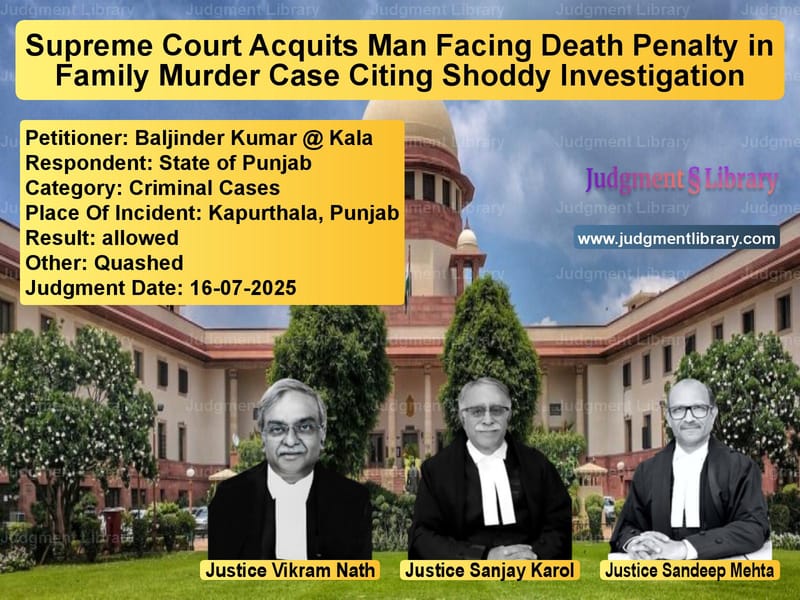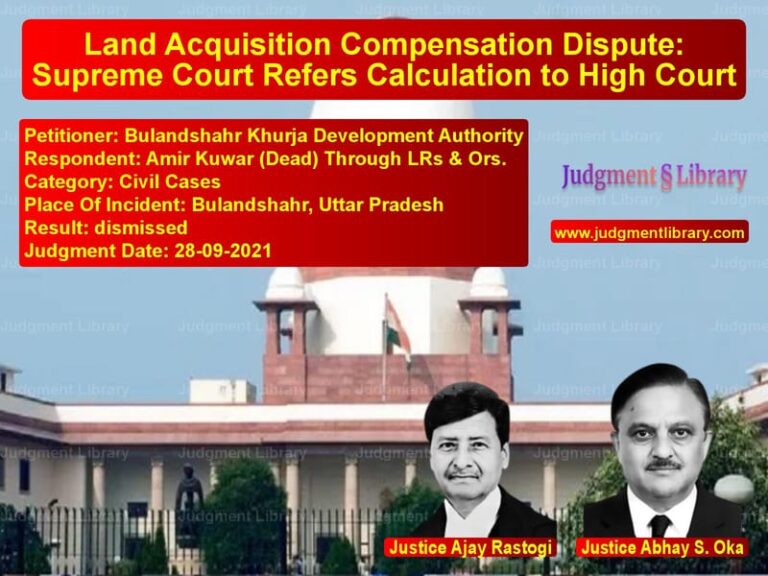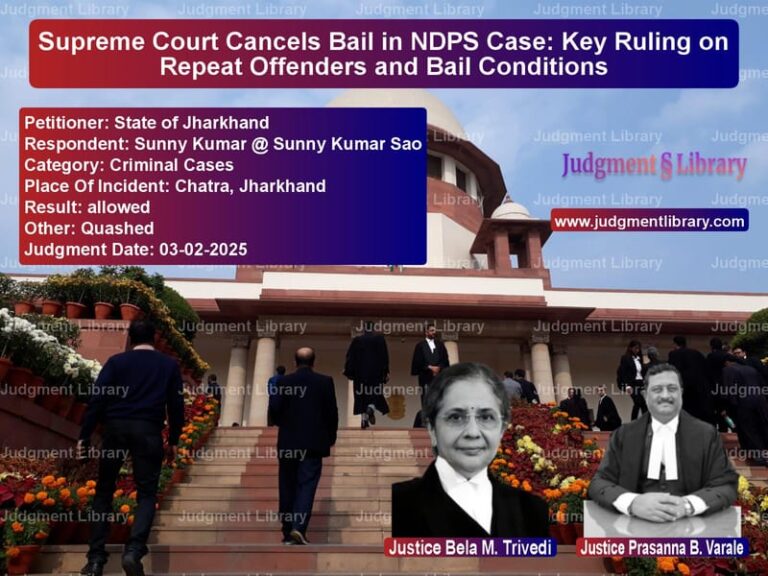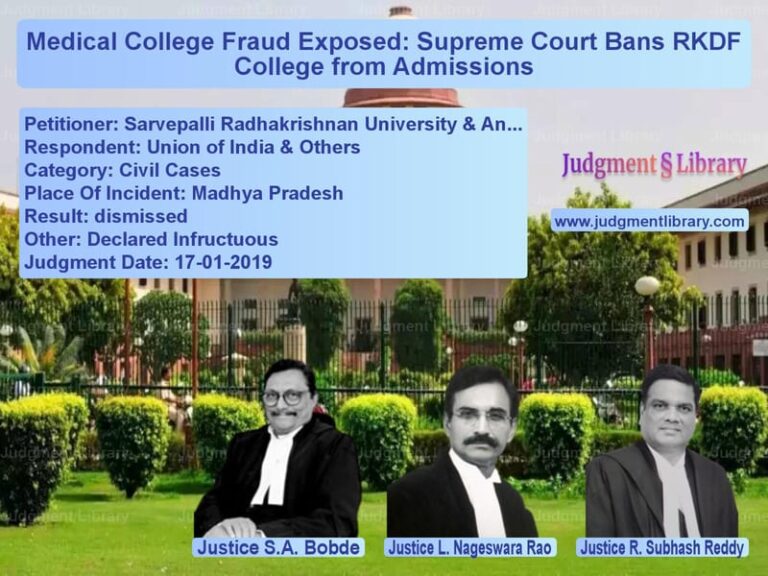Supreme Court Acquits Man Facing Death Penalty in Family Murder Case Citing Shoddy Investigation
In a powerful judgment that underscores the fundamental principle of “proof beyond reasonable doubt,” the Supreme Court of India has acquitted Baljinder Kumar @ Kala, who was sentenced to death for the murder of four family members, including his wife and two young children. The case, which had shocked a quiet Punjab village in 2013, saw the appellant spend over eleven years in prison before the Supreme Court found glaring inconsistencies in the prosecution’s case and serious lapses in the investigation. The Court’s detailed analysis revealed a prosecution story built on contradictory witness testimonies and questionable evidence, ultimately leading to the conclusion that the guilt of the accused had not been proven beyond reasonable doubt.
A Village Awakened by Tragedy
The horrific incident occurred on the morning of November 29, 2013, when four members of a family were found dead in their home in Kapurthala, Punjab. The victims included Seema Rani (the appellant’s wife), Reena Rani (his sister-in-law), and two young children – Sumani Kumari (aged 3-4 years) and Harsh (aged 1.5-2 years). Two other family members, Harry (aged 5 years) and Om Prakash (aged 18 years), sustained grievous injuries but survived. The prosecution alleged that Baljinder Kumar, the father of the deceased children, was the perpetrator, motivated by a financial dispute involving Rs. 35,000 related to his sister’s divorce where his mother-in-law had stood as guarantor.
The Legal Journey Through Lower Courts
The Trial Court convicted Baljinder Kumar under Section 302 of IPC on four counts and sentenced him to death, categorizing the case as “rarest of rare.” The Court relied heavily on the testimonies of three key witnesses: PW1-Vijay Kumar (complainant and brother of the deceased), PW2-Manjit Kaur (mother of the deceased and alleged eyewitness), and PW17-Harry (injured child witness). The High Court later upheld the conviction and death sentence, though it did acknowledge some inconsistencies in the prosecution’s case.
The Supreme Court’s Scrutiny
The Supreme Court, comprising Justices Vikram Nath, Sanjay Karol, and Sandeep Mehta, conducted a meticulous examination of the evidence and found fatal flaws in the prosecution’s case. The Court began its analysis by observing the enormous pressure on investigating agencies in such sensational cases, noting that “the breakdown of the legal system becomes apparent when such haste to lay a finger of blame on somebody leads to a shoddy investigation and a poorly conducted trial. The result is a loosely tied prosecution case with glaring loopholes all across and yet the Courts’ enthusiasm to deliver justice in such a heinous crime ensures that the accused person ends up on the death row, albeit without sufficient evidence.”
Contradictions in Key Witness Testimonies
The Court’s analysis revealed shocking contradictions between the two main eyewitnesses. PW1-Vijay Kumar, in his FIR and initial statements, claimed the accused was carrying a ‘datar’ (a different weapon) and was accompanied by 3-4 unidentified persons. However, during trial, he changed his testimony to say the accused was carrying a ‘gandasi’ (the weapon allegedly recovered later) and made no mention of accompanying persons. The Court noted that “a subsequent and convenient switching of statements by a key witness with regard to seeing the accused with the said weapon only points towards the fabricated nature of such a statement.”
Even more damaging was the contradiction regarding PW2-Manjit Kaur’s presence at the crime scene. PW1 initially stated in his FIR that his mother had gone to the Gurudwara at 6 a.m., but later claimed she was present during the incident. The Court found that “PW2’s presence in the house during the occurrence becomes doubtful from the initial stage itself as PW1 nowhere mentions her presence in the FIR which was registered on the day of the incident itself. It is unfathomable that the complainant would narrate the sequence of events and would miss out on such a major and traumatic detail as to his own mother witnessing the murder of her children and grandchildren.”
Questionable Recovery of Evidence
The prosecution’s case relied heavily on the recovery of a gandasi and blood-stained clothes allegedly based on the appellant’s disclosure statement. However, the recovery was made two months after the incident without any independent witnesses. The forensic evidence was equally weak – the chemical analysis report merely stated that the blood was of human origin, without specifically linking it to the victims. The Court noted with concern that “the weapon was misplaced at a later stage and no forensic analysis placed before the Court. It clearly and amply reflects the regard that has been held due towards investigative protocols in the instant case and is utterly deplorable.”
The Child Witness’s Testimony
The Court also examined the testimony of PW17-Harry, the injured child witness, and found that while his presence at the scene was undeniable, he explicitly stated during cross-examination that he did not witness the actual incident as he was half-asleep. The Court observed that “the injured witness did not actually ‘witness’ the incident. In his cross-examination, he admits that he was sleeping throughout the incident. He states that he did not see the appellant as he was half-asleep and specifically states that he did not see the appellant inflicting injuries on the deceased persons.”
Improper Application of Legal Principles
The Supreme Court strongly criticized the High Court’s application of Section 106 of the Evidence Act, which places the burden of explaining certain facts on the accused. The High Court had drawn adverse inference from the appellant’s failure to explain injuries he sustained on the same day, which later led to the amputation of his arm. The Supreme Court held that “given the fact that the prosecution has not been able to establish the presence of accused at the site of crime through direct, circumstantial, oral or forensic evidence, taking recourse to Section 106 of the Evidence Act and employ it against the accused in a detrimental manner in the absence of any foundational facts, shall lead to a severe and unwarranted application of the provision.”
The Final Ruling
After thorough analysis, the Supreme Court concluded that “when there remains practically nothing to link the accused-appellant to the scene of the crime, an alleged monetary dispute between the parties shall not by itself aid the prosecution case enough to frame the accused for a charge of murder on multiple counts.” The Court emphasized that “merely lack of an alternative plausible explanation to the incident cannot serve as enough evidence in itself to send a man to the gallows, whose guilt otherwise remains unestablished.”
In its final ruling, the Court allowed the appeals and acquitted the appellant of all charges, ordering his immediate release after over eleven years of incarceration. The judgment serves as a powerful reminder of the fundamental principle that in criminal jurisprudence, it is better that ten guilty persons escape than that one innocent suffer. The Court’s meticulous examination of evidence and its refusal to let the brutality of the crime override the requirement of strict proof beyond reasonable doubt reinforces the foundational values of India’s criminal justice system.
Petitioner Name: Baljinder Kumar @ Kala.Respondent Name: State of Punjab.Judgment By: Justice Vikram Nath, Justice Sanjay Karol, Justice Sandeep Mehta.Place Of Incident: Kapurthala, Punjab.Judgment Date: 16-07-2025.Result: allowed.
Don’t miss out on the full details! Download the complete judgment in PDF format below and gain valuable insights instantly!
Download Judgment: baljinder-kumar-@-ka-vs-state-of-punjab-supreme-court-of-india-judgment-dated-16-07-2025.pdf
Directly Download Judgment: Directly download this Judgment
See all petitions in Murder Cases
See all petitions in Attempt to Murder Cases
See all petitions in Custodial Deaths and Police Misconduct
See all petitions in Legal Malpractice
See all petitions in Other Cases
See all petitions in Judgment by Vikram Nath
See all petitions in Judgment by Sanjay Karol
See all petitions in Judgment by Sandeep Mehta
See all petitions in allowed
See all petitions in Quashed
See all petitions in supreme court of India judgments July 2025
See all petitions in 2025 judgments
See all posts in Criminal Cases Category
See all allowed petitions in Criminal Cases Category
See all Dismissed petitions in Criminal Cases Category
See all partially allowed petitions in Criminal Cases Category







